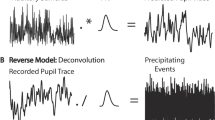Abstract
A new method which permits, in a single measurement, the determination of the moment of inertia, the angular damping coefficient of the joint and the location of the centre of mass of a body segmentin situ is presented. The underlying principle is the theory of small, damped oscillations of a system about its equilibrium position. The fact that the oscillogram contains information about certain parameters of the oscillating system is used to find these parameters. The application of the method is simple and does not require highly sophisticated instrumentation. The results are very reproducable and immediately available.
Similar content being viewed by others
References
Bouisset, S., Pertuzon, E.: Experimental determination of the moment of inertia of limb segments. In: Medicine and sport, Vol. II, J. Wartenweiler, ed., pp. 106–109. New York: Karger 1968
Casper, R. M., Jacobs, A. M., Kenney, E. S., McMaster, I. B.: On the use of gamma ray images for determination of human body segment parameters. Lecture given at Quantitative Imagery in Biomedical Sciences, Houston, Texas (1971)
Cavanagh, P. R., Gregor, R.: The quick-release method for estimating the moment of inertia of the shank and foot. In: Biomechanics IV, R. C. Nelson, C. A. Morehouse, eds., pp. 524–530. Baltimore: University Park Press 1974
Clauser, C. E., McConville, J. T., Young, J. W.: Table 32. In: Weight, volume, and center of mass of segments of the human body, p. 96. Doc. Rept. AMRL-TR-69-70, Wright-Patterson Air Force Base, Ohio (1969)
Dempster, W. T.: Space requirements of the seated operator. WADC Techn. Rept. 55–159, Wright-Patterson Air Force Base, Ohio (1955)
Fenn, W. O.: The mechanics of muscular contraction in man. J. appl. Physics9, 165–177 (1938)
Frankel, H. V., Burstein, A. H.: Orthopaedic biomechanics, p. 102. Philadelphia: Lea & Febiger 1970
Hatze, H.: The complete optimization of a human motion. Math. Biosci. (in press)
Hill, A. V.: The dynamic constants of human muscle. Proc. roy. Soc. B128, 263–274 (1940)
Miller, D. I., Nelson, R. C.: Biomechanics of sport, p. 94. Philadelphia: Lea & Febiger 1973
Otáhal, S.: A method of measuring some kinetic properties of voluntary muscle activity. In: Biomechanics II, J. Vredenbrecht, ed., pp. 181–184. New York: Karger 1971
Wilkie, D. R.: The relation between force and velocity in human muscle. J. Physiol. (Lond.)110, 249–280 (1950)
Author information
Authors and Affiliations
Rights and permissions
About this article
Cite this article
Hatze, H. A new method for the simultaneous measurement of the moment of inertia, the damping coefficient and the location of the centre of mass of a body segmentin situ . Europ. J. Appl. Physiol. 34, 217–226 (1975). https://doi.org/10.1007/BF00999935
Received:
Issue Date:
DOI: https://doi.org/10.1007/BF00999935




